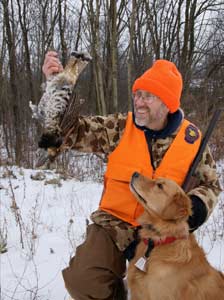
 An old adage about grouse hunting says, "Guns don't kill grouse. Boots kill grouse." There's little argument that the hunter that covers the most good grouse habitat will most likely put up the most birds – the key word being habitat. For the expenditure of boot leather to be a productive one, it needs to be spent in the right places.
An old adage about grouse hunting says, "Guns don't kill grouse. Boots kill grouse." There's little argument that the hunter that covers the most good grouse habitat will most likely put up the most birds – the key word being habitat. For the expenditure of boot leather to be a productive one, it needs to be spent in the right places.
Ruffed grouse – and woodcock as well – prosper in early successional habitats rich in young forests and shrubs. Mature timber, which in many places dominates the today's landscape, doesn't provide the high quality food and cover options required. So, to find the birds you must first find the pockets where they live.
Given the level of information readily available today, locating potential hunting areas before you even leave home has never been easier.
Consider These Online Examples to Find Areas to Hunt
Internet resources like Google Earth and Bing Maps provide you with a bird's eye view of terrain. Also, on certain public lands maps are available that show timber cuts – along with the general age of the cuts – which are likely to provide quality grouse and woodcock habitat. Oftentimes these maps can be downloaded from the web. And some private timber companies provide online maps that show hunters how to access lands where they allow, even encourage, hunting. Since active timbering is often more widespread on private lands (land managers must combat the preservationist mentality to cut on public lands), this can be especially beneficial. While the motivating factor is often to help the efficiently of deer hunters – forest regeneration prospers from deer numbers being kept in check – grouse hunters also profit, both in access and in early stage habitats.
A few decades ago, when I was in my hunting infancy and absorbing all the knowledge I possibly could on learning new areas, the advice of the time was, "Buy detailed topographic maps, and if available, aerial photographs." It was a burdensome and somewhat expensive process. Not anymore. The information program Google Earth, and web mapping services such as Bing Maps and Google Maps, provides aerial and satellite imagery accessible by way of a few mouse clicks.
Though there are differences between these three resources, all of them provide hunters with the ability to study territory to evaluate its attractiveness to birds. Google Earth is a program that can be downloaded free of charge. Both Bing Maps and Google Maps are internet mapping services that include aerial looks. All three require a working high-speed Internet connection.
Similar to learning the features of a new fishing sonar unit, benefitting from these programs/services takes a bit of usage to understand what you're looking at. Since a primary objective will be to locate regenerating types of habitat, start off by examining some of your current productive covers to see what they look like from a few hundred meters above ground. Chances are your pet areas will have plenty of broken cover and edges, as compared to the appearance of monotonous,unbroken expanses of large tracts of mature timber. Your woodcock patches will likely include a stream or boggy area, something to keep in mind when looking for similar spots.
Understand that the quality and age of imagery differs depending on the area you're exploring. In general, images are often older in rural/remote areas – the regions you will be looking at. Pictures can be blurry if cloud cover was present when taken, but the imagery is constantly being updated. Overall, quality is good now and will only get better with time.
One of the major advantages of Google Earth (as compared to the other resources) is that the image date is posted on the left hand bottom of the screen. If you're looking at pictures taken eight years ago, remember that eight years can make a difference in the life of a grouse or woodcock cover. Habitat that looks good might be getting a bit too tall for good hunting; conversely, something that was obviously clear-cut (at the time of the photo) might be reaching prime age. Pictures taken during the winter won't show leaves, so the terrain will have a more barren look. Also, newer photos are of a higher resolution. Many of the areas I hunt and fish in my home area of northwestern Pennsylvania have imagery taken within the last six months. The detail is scary. I can zoom in and clearly see individual rocks along one of my favorite trout streams!
The potential of this effort goes well beyond simply scanning the landscape for would-be hunting spots. It becomes an ongoing, interactive relationship where, in conjunction with handheld GPS use, at day's end a bird's-eye look can be taken of places one hunted earlier.
For instance, following a hunt I made last fall to northern Michigan, I marked waypoints on productive covers my partner and I located. At the end of the hunt, by typing the waypoint coordinates into Google Earth I was able to examine these spots. Equally importantly it enabled me to find similar covers nearby, separated by a band of tall timber (you wouldn't know they were there from ground level), located farther from the road, and less pressured by other hunters. By gathering up the GPS coordinates off of Google Earth and manually entering them into my handheld GPS, I was able to continue on to the "new spots" during subsequent outings.
Which brings up another nice feature of Google Earth: The lat/long coordinates are displayed on the bottom of the screen, relative to cursor location. You can also get the coordinates off of Google Maps. Put the cursor on the desired location. A right click will open a window. One of the options is "what's here?" Left clicking that option will place a green arrow icon on the screen. Move the cursor over the arrow and the coordinates will appear.
You'll discover, as you begin working with coordinates that several formats exist, including the signed degrees format where the numbers are expressed as decimals, and the degrees-minutes-seconds format. There are many free online converters you can use to translate coordinates to the format you need. Also, most handheld GPS units allow you to choose a format for marking waypoints, so you can set it up to be consistent with the "language" of the internet program you are using. Personally, I like working with the decimal format. That system also works well for entering coordinates in my truck's Garmin. So the access spots of interesting areas found on Google Earth can be logged into that unit, and I can drive right to them.
Earlier I mentioned grouse habitat maps. For example, on its website, Huron-Manistee National Forest provides maps of clear-cuts coded by general age. Used side-by-side with Google Earth, these maps can really save on the boot leather. Other national forests around the Great Lakes states have similar maps.
In regard to large tracts of private land, Collins Pine Company is a good instance of a timber company that's hunter friendly. Managing over a hundred thousand acres of forest in northern Pennsylvania, the company provides a recreation link on its website that takes visitors to a series of maps of areas open to public hunting, including bits with good grouse and woodcock habitat.
These points are some of the most significant ones for planning/finding birdy areas. But you can certainly take things further. State forests (as opposed to national forests) are often actively timbered, though specific information regarding such is thin on the web. You can, however, often find contact information for the proper forester; they can tell you about areas logged five to 15 years ago that could be productive now. Also, many state DNRs have cooperative land access programs with private landowners. Information pertaining to such programs is often listed on that agency's website.
- 8811 views

